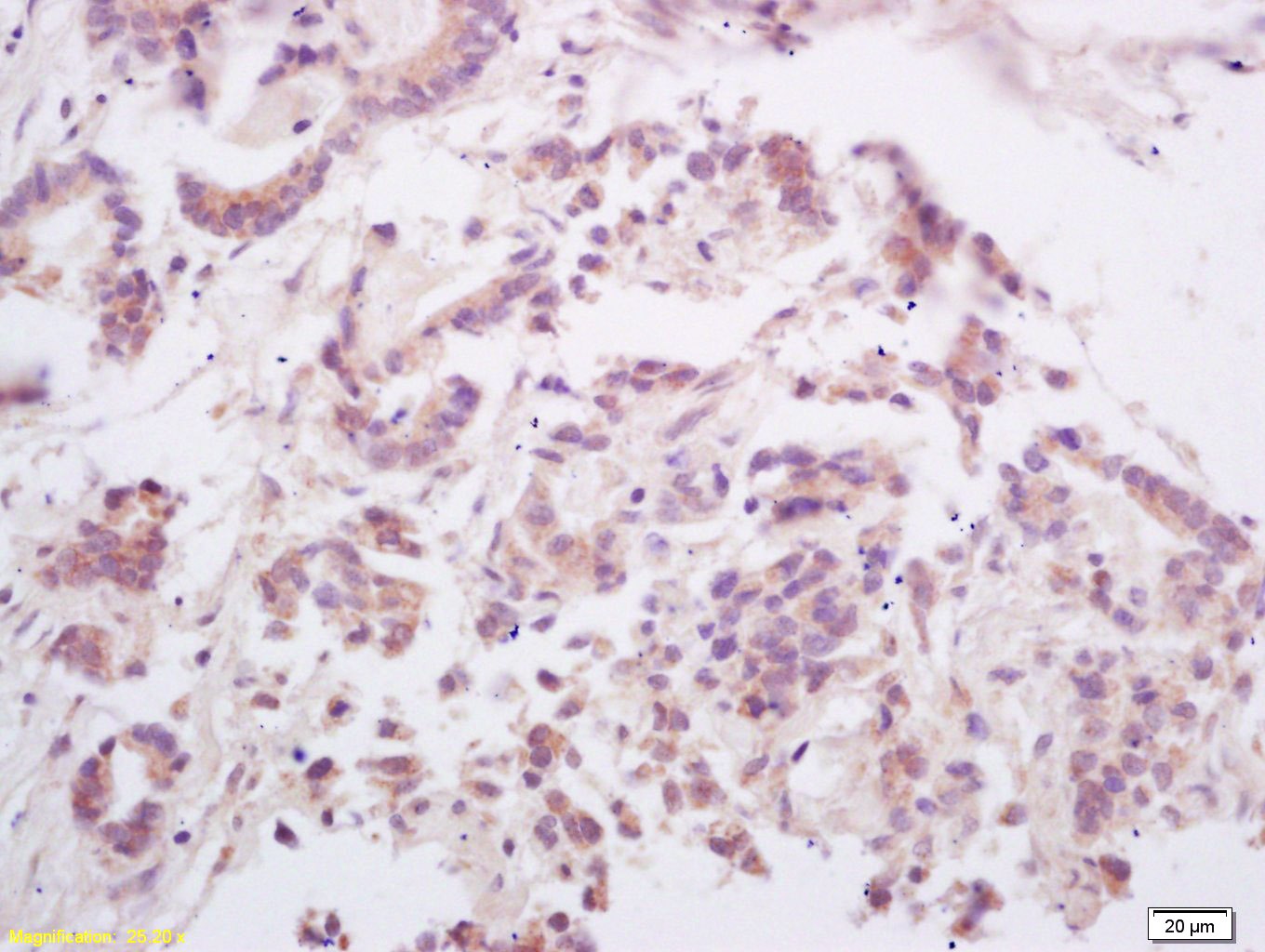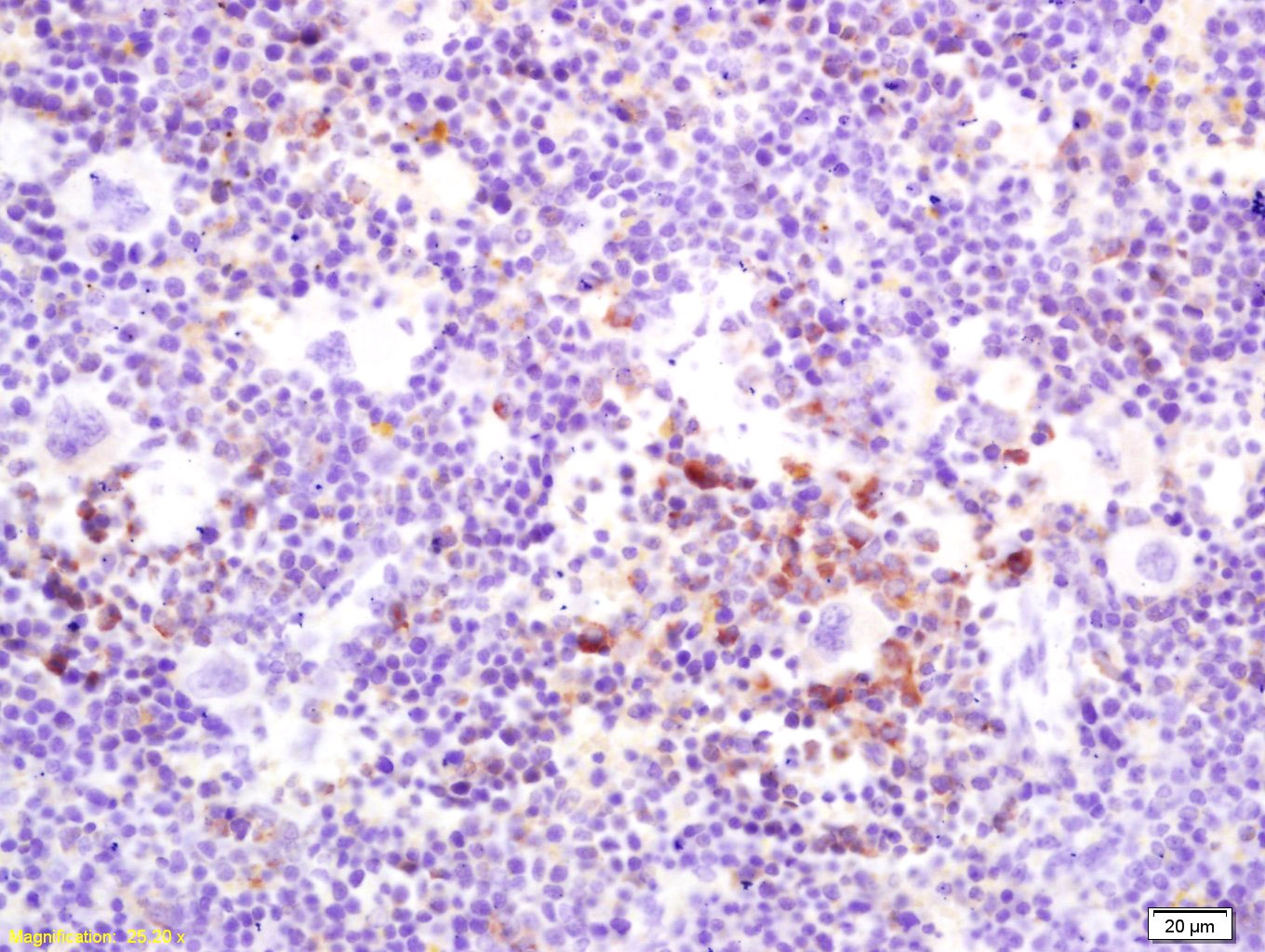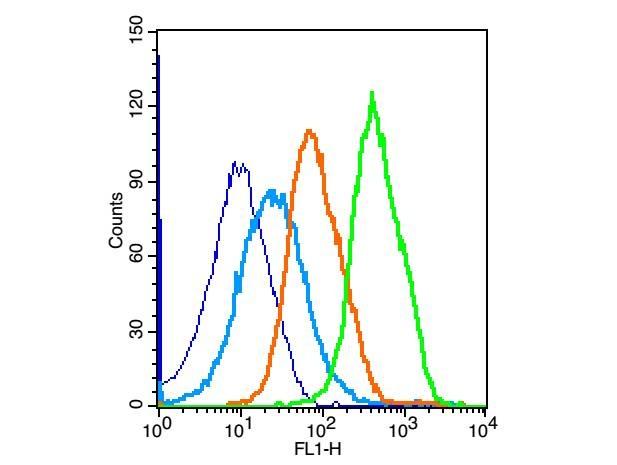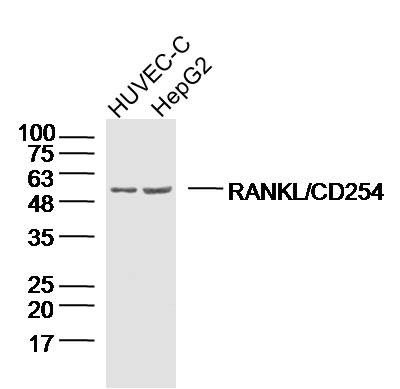Shopping Cart
- Remove All
 Your shopping cart is currently empty
Your shopping cart is currently empty
Anti-RANKL/TNFSF11/CD254 Polyclonal Antibody is a Rabbit antibody targeting RANKL/TNFSF11/CD254. Anti-RANKL/TNFSF11/CD254 Polyclonal Antibody can be used in FCM,IF,IHC-Fr,IHC-P,WB.
| Pack Size | Price | Availability | Quantity |
|---|---|---|---|
| 50 μL | $220 | 7-10 days | |
| 100 μL | $372 | 7-10 days | |
| 200 μL | $528 | 7-10 days |
| Description | Anti-RANKL/TNFSF11/CD254 Polyclonal Antibody is a Rabbit antibody targeting RANKL/TNFSF11/CD254. Anti-RANKL/TNFSF11/CD254 Polyclonal Antibody can be used in FCM,IF,IHC-Fr,IHC-P,WB. |
| Synonyms | tumor necrosis factor ligand superfamily member 11, TNFSF11, Receptor activator of nuclear factor κ-B ligand, Receptor activator of nuclear factor kappa-B ligand, RANK L, Osteoclast differentiation factor, OPGL, ODF, CD254 |
| Ig Type | IgG |
| Reactivity | Human,Mouse (predicted:Rat,Dog) |
| Verified Activity | 1. Tissue/cell: human gastric carcinoma; 4% Paraformaldehyde-fixed and paraffin-embedded; Antigen retrieval: citrate buffer (0.01M, pH6.0), Boiling bathing for 15 min; Block endogenous peroxidase by 3% Hydrogen peroxide for 30 min; Blocking buffer (normal goat serum) at 37°C for 20 min; Incubation: Anti-OPGL/RANKL/ODF Polyclonal Antibody, Unconjugated (TMAB-01609) 1:200, overnight at 4°C, followed by conjugation to the secondary antibody and DAb staining. 2. Tissue/cell: mouse spleen tissue; 4% Paraformaldehyde-fixed and paraffin-embedded; Antigen retrieval: citrate buffer (0.01M, pH6.0), Boiling bathing for 15 min; Block endogenous peroxidase by 3% Hydrogen peroxide for 30 min; Blocking buffer (normal goat serum) at 37°C for 20 min; Incubation: Anti-OPGL/RANKL/ODF Polyclonal Antibody, Unconjugated (TMAB-01609) 1:200, overnight at 4°C, followed by conjugation to the secondary antibody and DAb staining. 3. Blank control: mouse splenocytes (blue) Isotype Control Antibody: Rabbit Igg (orange); Secondary Antibody: Goat anti-rabbit IgG-FITC (white blue), Dilution: 1:100 in 1 X PBS containing 0.5% BSA; Primary Antibody Dilution: 1 μL in 100 μL 1X PBS containing 0.5% BSA (green). 4. Sample: HUVEC-C Cell (Human) Lysate at 40 μg HepG2 Cell (Human) Lysate at 40 μg Primary: Anti-RANKL/CD254 (TMAB-01609) at 1/300 dilution Secondary: IRDye800CW Goat Anti-Rabbit IgG at 1/20000 dilution Predicted band size: 35 kDa Observed band size: 56 kDa 5. Sample: LympHnode (Mouse) Lysate at 40 μg Thymus (Mouse) Lysate at 40 μg Primary: Anti-RANKL/CD254 (TMAB-01609) at 1/500 dilution Secondary: IRDye800CW Goat Anti-Rabbit IgG at 1/20000 dilution Predicted band size: 37/50 kDa Observed band size: 50 kDa      |
| Application | |
| Recommended Dose | WB: 1:500-2000; IHC-P: 1:100-500; IHC-Fr: 1:100-500; IF: 1:100-500; FCM: 1μg/Test |
| Antibody Type | Polyclonal |
| Host Species | Rabbit |
| Subcellular Localization | Cytoplasm; Secreted and Cell membrane. |
| Tissue Specificity | Highest in the peripheral lymph nodes, weak in spleen, peripheral blood Leukocytes, bone marrow, heart, placenta, skeletal muscle, stomach and thyroid. |
| Construction | Polyclonal Antibody |
| Purification | Protein A purified |
| Appearance | Liquid |
| Formulation | 0.01M TBS (pH7.4) with 1% BSA, 0.02% Proclin300 and 50% Glycerol. |
| Concentration | 1 mg/mL |
| Research Background | This gene encodes a member of the tumor necrosis factor (TNF) cytokine family which is a ligand for osteoprotegerin and functions as a key factor for osteoclast differentiation and activation. This protein was shown to be a dentritic cell survival factor and is involved in the regulation of T cell-dependent immune response. T cell activation was reported to induce expression of this gene and lead to an increase of osteoclastogenesis and bone loss. This protein was shown to activate antiapoptotic kinase AKT/PKB through a signaling complex involving SRC kinase and tumor necrosis factor receptor-associated factor (TRAF) 6, which indicated this protein may have a role in the regulation of cell apoptosis. Targeted disruption of the related gene in mice led to severe osteopetrosis and a lack of osteoclasts. The deficient mice exhibited defects in early differentiation of T and B lymphocytes, and failed to form lobulo-alveolar mammary structures during pregnancy. Two alternatively spliced transcript variants have been found. [provided by RefSeq, Jul 2008]. |
| Immunogen | KLH conjugated synthetic peptide: human OPGL |
| Antigen Species | Human |
| Gene Name | TNFSF11 |
| Gene ID | |
| Protein Name | Tumor necrosis factor ligand superfamily member 11 |
| Uniprot ID | |
| Biology Area | Thrombosis,Regulatory T Cells,TNF Superfamily |
| Function | Cytokine that binds to TNFRSF11B/OPG and to TNFRSF11A/RANK. Osteoclast differentiation and activation factor. Augments the ability of dendritic cells to stimulate naive T-cell proliferation. May be an important regulator of interactions between T-cells and dendritic cells and may play a role in the regulation of the T-cell-dependent immune response. May also play an important role in enhanced bone-resorption in humoral hypercalcemia of malignancy. |
| Molecular Weight | Theoretical: 35 kDa. |
| Stability & Storage | Store at -20°C or -80°C for 12 months. Avoid repeated freeze-thaw cycles. |
| Transport | Shipping with blue ice. |

Copyright © 2015-2025 TargetMol Chemicals Inc. All Rights Reserved.